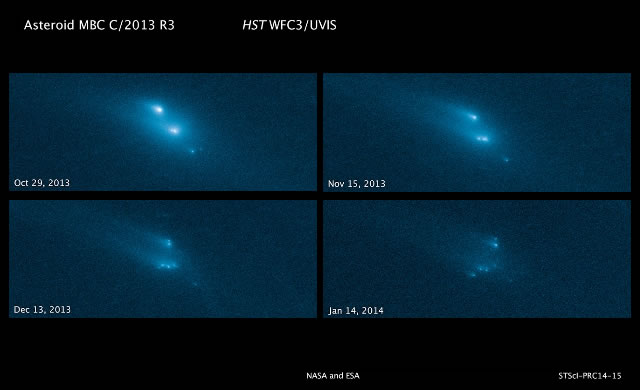
Credit: NASA, ESA, D. Jewitt/UCLA
Fotografato da terra e dallo spazio mentre continua a sfaldarsi, probabilmente a causa dell’effetto YORP: l’aumento della forza centrifuga indotto dalla luce solare. Denominato P/2013 R3, si trova nella Fascia principale, a quasi mezzo miliardo di chilometri dal Sole.
Prima erano tre. Poi cinque. E nell’ultima immagine acquisita dal telescopio spaziale Hubble di frammenti se ne contano dieci. I quattro più grandi hanno un raggio di circa 200 metri, e mettendoli tutti sulla bilancia la lancetta segnerebbe qualcosa come 200mila tonnellate, briciola più briciola meno. Questo è quanto si legge nell’ultimo bollettino – nella fattispecie, un articolo appena pubblicato su Astrophysical Journal Letters – relativo a P/2013 R3: un oggetto individuato per la prima volta il 15 settembre del 2013 dai telescopi delle survey Catalina e Pan-STARRS, a circa mezzo miliardo di km dal Sole, nella cosiddetta Fascia principale.
Fonte/Leggi tutto → Media.INAF.it
Astronomers have witnessed for the first time the breakup of an asteroid into as many as 10 smaller pieces. The discovery is published online March 6 in Astrophysical Journal Letters. Though fragile comet nuclei have been seen falling apart as they near the sun, nothing resembling this type of breakup has been observed before in the asteroid belt.
NASA’s Hubble Space Telescope photographed the demolition. “Seeing this rock fall apart before our eyes is pretty amazing,” said David Jewitt, a professor in the UCLA Department of Earth, Planetary and Space Sciences and the UCLA Department of Physics and Astronomy, who led the astronomical forensics investigation. The crumbling asteroid, designated P/2013 R3, was first noticed as an anomalous, fuzzy-looking object on Sept. 15, 2013, by the Catalina and Pan-STARRS sky-survey telescopes. A follow-up observation on Oct. 1 with the W.M. Keck telescope on Hawaii’s Mauna Kea revealed three co-moving bodies embedded in a dusty envelope that is nearly the diameter of Earth.
Source/Continue reading → Phys.org

















